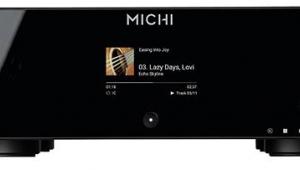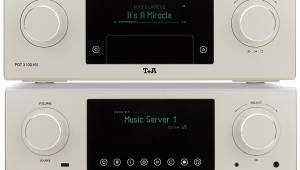Rega Saturn Cd Player (£1298)
Named after the ‘Bringer of Old Age’, the Saturn builds on the strengths of the outwardly identical Apollo reviewed in February 2007. Both come in black or silver sculpted aluminium casework. Here, improvements have been made to transport, master clock, analogue conversion and power supplies.
With a 435 x 270mm footprint (wd), the player needs a minimum height clearance of 180mm to allow the damped lid to lift – it angles back as it is raised. Replacing the puck of the Rega Planet and Jupiter there’s a quite stiff triple ball-race grip on the CD. So without recourse to a cloth, marking the centre of the disc with the fingertips is almost unavoidable during loading (or am I just being pernickety?). The space to get your hand in to lift out the CD is also minimal, and I would have preferred slight angling of the finger cutouts, which are set on a north–south axis.
VICTOR MELDREW
So, changing discs with this machine is no fun, but Rega argues that motorised drawer mechanisms can fail and that its underslung transport facilitates service access to the laser diode assembly. To get a couple of other small gripes out of the way, the set-flush fascia controls – play/pause, stop, track previous or next – are hard to see under low lighting, as they are black on black. However, within only a matter of hours the fingers find them quite automatically, Braille-style.
With the elegant dedicated remote, track selection, programming, etc is perfectly straightforward. (Three buttons are designated for future use only.) Choosing CD tracks from ten onwards you first push the >10 button, key in the requisite number then press play. There is a similar >100 key. Remaining track times may be shown via the remote. The display provides information for CDs in addition to CD-R/RW discs containing MP3 or WMA files. With the display muted, changing tracks momentarily re-illuminates the window, although I detected no audible improvement from this ‘Display Off’ facility.
WAIT FOR IT!
A 12s delay before you hear any music is a well documented feature of Rega’s current players. But changing tracks within an initialised disc is quite rapid. It took even less time to appreciate the pace and swing of André Previn with bassist David Finck in ‘Oh, Lady Be Good’ and ‘I Got Rhythm’ from Live At The Jazz Standard [Decca] – you could sense the pianist ‘thinking’ his way through the piece as he played. Castanets were clearly articulated and the ‘plink’ of harp some seconds into Miles Davis’ Sketches Of Spain [Sony]. The ‘characters’ represented by flute, oboe, clarinet and bassoon in the Erato Peter and the Wolf were tonally well related, and the close-miked voice of Patrick Stewart narrating was clearly a studio overlay. A good result was also achieved with the choir and solo voices of The Tallis Scholars’ remake of Allegri’s Miserere.
RUNNING ON EMPTY
The Saturn offers a clean, clear presentation. But then I began to find some regular test material, which happened to be on hybrid SACDs, rather disappointing. When I compared Rachmaninov piano concertos with Stephen Hough/Andrew Litton, issued by Hyperion as both CD and SACD hybrid sets, and several Mercurys (where, unlike the RCA ‘Living Stereo’ hybrids, the 1990s transfers from analogue are stated to be unchanged) the CD layers were patently inferior to their pure CD equivalents, sounding glassy or anaemic. One hybrid even prompted a ‘disc empty’ warning, although it initialised perfectly on a second try. Interesting!
Over time I felt I was more the observer, detached rather than emotionally drawn into the music – this was very much at odds with Steve Harris’ findings with the Apollo, reviewed in the Feb ’07 issue. With my reference player, the long discontinued Meridian 508.20, soundstage elements had more ambient information, were more three-dimensional. The Saturn delivered flatter-sounding cutouts on a wide soundstage. The huge orchestral build-up in the Heifetz/RCA Sibelius Violin Concerto, 2m 40s into track 2, was particularly telling – flattened with the Rega, it was more properly dimensioned on the Meridian.
THE IDEAL PARTNER
While the Musical Fidelity X-DACV8 [HFN April ’07] was a mismatch with my Meridian, the Saturn, used here as CD transport, raised its performance to an exceptional audiophile standard. On Peter and the Wolf, the oboe was creamier, the bassoon woodier. The musical line flowed and the soundstage filled out. With Hyperion’s recent recording of Hartmann’s Concerto funèbre one could hear the Henry Wood Hall resonance, gauge exactly what space lay before and behind each section of the string orchestra.
As an integrated player, the Saturn made the solo violin works coupled on this disc sound flatter and less focused. But as a CD transport, playing the Jazz Standard live album, the string bass was now set back further, in timbre more dry and controlled. This sound, unquestionably the best digital reproduction I’ve heard at home, was a marriage made in heaven – albeit at a wedding cost of another £999.
VERDICT
This solidly built player is simple to use, with a dedicated, well-designed remote offering more facilities without overcomplication. The top-loading chamber is a bit confined and fiddly, we think. The digital output offers exceptional sound quality but the analogue section, not faulted for timing or tonal quality, lacks soundstage depth and a real sense of involvement.
Originally published in the January 2008 issue




























































